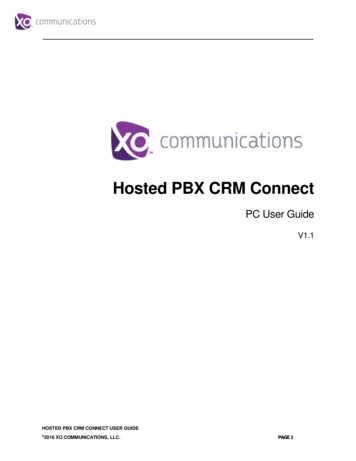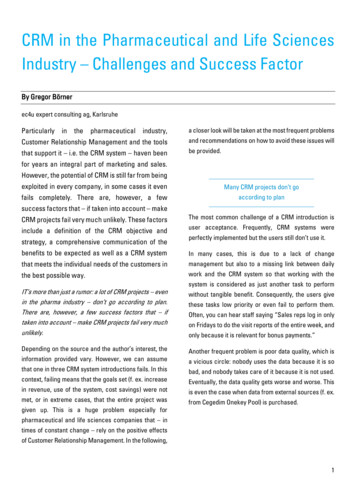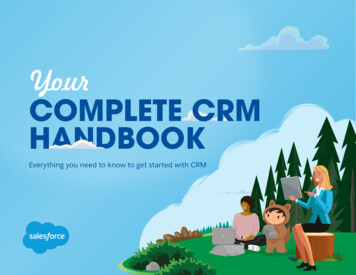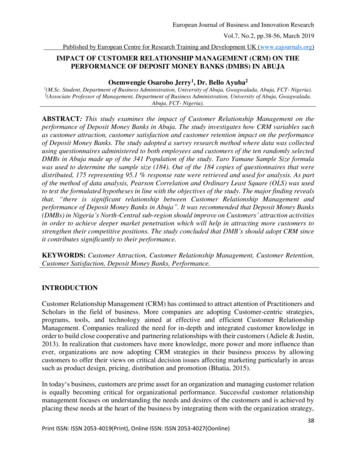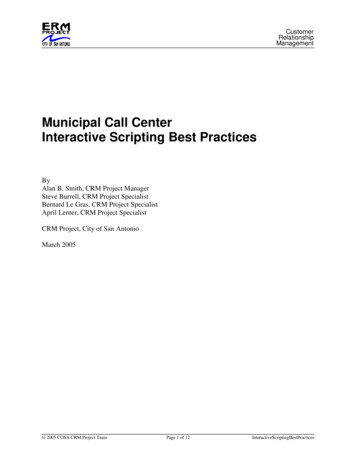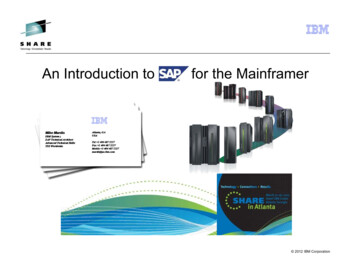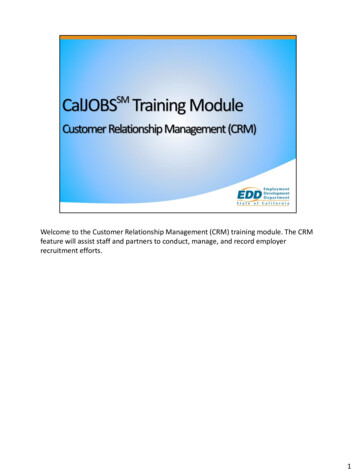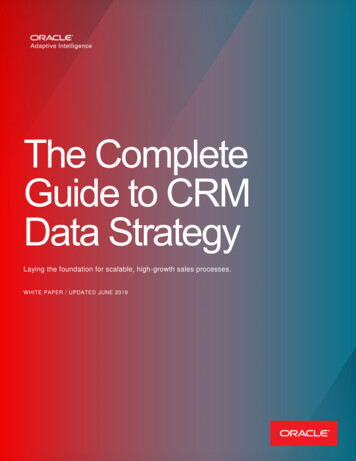
Transcription
E-BookCRM in financial services: Bestpractices, trends and strategy forthe new economyFind out how financial services companies are leveraging CRMtechnology and best practices to improve service and operationalefficiency. Learn how things like security, customer segmentation anda complete view of the customer are central to successful CRM forfinancial services firms and the best practices for tackling these issues.Finally, get expert insight into trends that could affect your short andlong term strategies. Professionals in IT, operations or business willfind tips, advice and inspiration for CRM strategy development infinancial services organizations.Sponsored By:
SearchCRM.com E-BookCRM in financial services: Best practices, trends and strategy for the new economyE-BookCRM in financial services: Bestpractices, trends and strategy for thenew economyTable of ContentsCRM in financial services: strategies for actionNew CRM technologies bring cost savings and faster customer service infinancial industryFinancial industry must improve online services to satisfy customerexpectationsCRM in financial services: The rise of the customerResources from Pivotal CRM, a CDC Software solutionSponsored By:Page 2 of 23
SearchCRM.com E-BookCRM in financial services: Best practices, trends and strategy for the new economyCRM in financial services: strategies for actionBy Chris Maxcer, ContributorFinancial services firms face unique challenges in managing their customer relationships,but a new wave of technology and best practices are helping to guide the way.For most businesses, truly understanding the customer seems an insurmountable challengeStill, there are strategies and methods that can cut the madness for financial services firms,even as they sort through their unique CRM challenges.The insurance industry, for instance, is facing product and go-to-market complexities thatneed different types of CRM strategies for success.At the heart of the insurance industry is the relationship between insurance providers, theiragents, and end customer policyholders. Consequently, insurance providers mustunderstand their agents while they also need an intimate understanding of policyholders."Most CRM projects in insurance companies have been business-to-business (agents) butmost are wondering how they can beef up their business-to-consumer side," explainedKimberly Harris-Ferrante, a vice president and distinguished analyst with the insuranceindustry advisory service at Stamford, Conn.-based Gartner Inc. "So they need tosimultaneously have part of the business B2B2C and part B2C running in parallel, and a lotof CRM systems aren't built to support both models running in a single instance for a singlecompany."As companies look to roll out CRM systems, Harris-Ferrante recommends they look fornewer-generation CRM systems that can handle both models."Even if an insurance company isn't planning to sell policies directly to consumers -irritating their agents -- one day their CEO or board might want to sell policies direct toconsumers, maybe with a different brand or logo," she said. "Maybe not now, but theseconversations will inevitably happen."Sponsored By:Page 3 of 23
SearchCRM.com E-BookCRM in financial services: Best practices, trends and strategy for the new economyFinancial services firms outside of insurance face similar challenges in managing customerdata.So how can these companies tackle CRM?Financial services firms are rolling out CRM projects, Harris-Ferrante said, just in theproperty and casualty division or the life insurance division -- all by line of business inrelatively isolated projects."So we find redundancy, and how can you have a single customer view if you've got four orfive single customer views by line of business?" she said. "We don't tell clients to stop doingCRM because their legacy policy systems are a mess."Instead, companies need to understand they are working on short-term tactical solutions."We recommend that companies build toward a common goal -- having, for example, astandard technology platform so that even if you are deploying on lines of business, you'redeploying with the same vendor so at some point you can reconcile since you wouldtheoretically have a common data structure, a common database, a single system intowhich you can pull it all together into a single instance -- even if you don't have a singleinstance today," Harris-Ferrante said."Having that governance, that vision, that enterprise strategy will help guide you, even ifyou're making short-term, tactical siloed approaches. We tell our clients to look ahead tohow they might pull this together as they work on the granular levels."Using technology to tease out best practicesAccording to Richard Snow, global vice president and research director for VentanaResearch's customer and contact center practice, financial services companies are rapidlybeginning to adopt smarter analytics products, which are being used to help understand the"voice of the customer."Sponsored By:Page 4 of 23
SearchCRM.com E-BookCRM in financial services: Best practices, trends and strategy for the new economy"I'm seeing the adoption of text analytics, speech analytics, social media analytics, and thenas you drill down further into technology, I see an increasing uptake in desktop analytics,"Snow said.Financial services firms, for example, can use analytics to show which agents are handlinghigh-value sales calls and see how well they do it, ultimately letting a company analyzethese successful processes.A handful of banking companies, Snow said, are working to use all of their customerinformation as they interact with the company to not only provide a 360-degree-view of thecustomer but also to manage the customer experience. If a bank, for example, knows thelast time a customer called a call center, what he responded to, the last time he was on theWeb, what he responded to in customer surveys, the bank can match that profile to a highvalue agent."A system can then advise an agent what they should be selling, what should they shouldbe cross-selling, and even vice versa, what shouldn't be offered," Snow said.Despite the tantalizing possibilities, Snow said most financial services firms need to realizethat a 360-degree-view of the customer is essentially a myth."Once you get through the hype, ask, which data sources can you get to? Because you'vegot CRM data, financial data, billing data, customer service data," Snow said."But now alsoyou have customer letters, emails, customer tweets, customer blogs, recordings of call.You've got so many sources of customer data in so many formats that bringing it alltogether into a fabled 360-degree-voice of the customer isn't really possible."There isn't a single vendor that can take every source of customer data, bring it alltogether, rationalize it, aggregate it and produce anything real," he said.Sponsored By:Page 5 of 23
SearchCRM.com E-BookCRM in financial services: Best practices, trends and strategy for the new economyMore than technology"Even before the technology, you have to know if you have the right products for thecustomers," Harris-Ferrante said. "We ask our clients to look at their products, and it's avery uncomfortable discussion because no one wants to admit they have the wrongproducts."Simpler insurance products like auto, home and term life insurance are being purchasedonline in more automatic, self-directed models at the same time these products arepackaged and sold with other products through agents. The processes and channels aredizzying."Companies are introducing process variety, moving from a one-size-fits-all approach to avery complex matrix of different processes, products and content based upondemographics, life stages and life events," Harris-Ferrante said. "What this now means isthat when you have a CRM conversation with an insurance company, you're simultaneouslyhaving a business process management conversation."In addition, insurance companies are incredibly siloed with both diverse and similar lines ofbusiness and brands. It's almost impossible to get all of the lines of business into a singleCRM instance, much less into a coherent strategy. Each line of business manager has theirown challenges and goals, and they can't exactly wait for a cohesive push from an executivemanagement team.In addition, customer and product data represent huge challenges."Most companies don't have the plumbing yet -- it's hard to think big picture if you don'thave the governance, structure, and accessible data," Harris-Ferrante said.Sponsored By:Page 6 of 23
SearchCRM.com E-BookCRM in financial services: Best practices, trends and strategy for the new economyPutting the pieces togetherKate Leggett, a senior analyst of customer service and call center processes for Cambridge,Mass.-based Forrester Research Inc., is seeing several trends that are paying off forfinancial services firms."I see a focus on the multichannel experience, the consistency of experience, from walkinginto store, being there, to online chat," Leggett said. On the back end, this is translated intoa deep integration of knowledge into CRM where corporate assets are available to agentsand customers in unified ways, so an agent in a retail environment has access to the samecustomer data as an agent in a call center."I see a deep focus on business process in CRM as an effort to standardize agent actionsand to be able to ensure that you meet compliance guidelines, which is especially importantin heavily regulated industry of financial services, where huge penalties can be incurred,"Leggett notes.Incorporating business intelligence into a CRM solution, Leggett says, can be one of themore effective ways to gain tangible CRM benefits.If two customers with essentially the same product profiles call a financial services firm,their experience may need to be radically different. If one is a happy customer, and theother is a dissatisfied customer who has called four or five times before, that's criticalinformation to have."If they call in, at what point do you push an offer to each of the customers? What offer doyou push? And is it even appropriate to push an offer?" Leggett said.Of course, if agents can use real-time analytics to help guide them, they can drasticallyaffect the outcome of either call -- and finding these areas of opportunity with agents canbe one of the more successful areas for CRM projects in financial services organizations.Sponsored By:Page 7 of 23
SearchCRM.com E-BookCRM in financial services: Best practices, trends and strategy for the new economyNew CRM technologies bring cost savings andfaster customer service in financial industryBy Sue Hildreth, ContributorWhat types of new CRM features should financial institutions like banks, mortgage firms,brokerages, and others be investing in, and what issues do financial services firms need toconsider before investing in new CRM products?While they may not be at the forefront of the latest wave of technology, banks and otherfinancial services firms are not so stodgy when it comes to embracing new customer-facingtools.The financial services industry has moved into online banking and webforms for submittingapplications, to taking a cautious look at social CRM channels, like blogs and forums.For example, ING Direct, a Wilmington, Del.-based bank which has over 85 million private,corporate and institutional clients in more than 50 countries has its own Facebook page.Lloyds TSB Commercial Finance has added self-service features like "Get an Instant Quote"and "Get in Touch" buttons to ask service to call them back.While things like Facebook, Twitter, member forums and chat may be new venues fortraditionally conservative businesses like banks and insurance firms, it is one thatcustomers clearly seem to want.A survey of corporate banking customers by Finextra and Pegasystems this year found that57% of respondents were willing to pay higher fees for an automated website that wouldallow them to access and manage all of their accounts.The survey also found that 62% of corporate customers would consider moving to adifferent bank to get better customer service. For both corporate and consumer bankcustomers, fast answers to problems and the ability to take care of issues quickly andeffectively are all important, even ranking above cost for many customers.Sponsored By:Page 8 of 23
SearchCRM.com E-BookCRM in financial services: Best practices, trends and strategy for the new economyCRM automation saves moneyWhile financial firms have been slower than some other industries -- notably retail -- toinvest in new CRM technologies, they are realizing that automating some of the simplercustomer service functions is one way to make customer service faster and more convenientfor customers while potentially saving money. It's also cheaper to provide, an especiallyimportant factor for servicing lower-end customers who may not have a lot of business witha bank but are still are valuable customers. Web-based self-service tools such as onlineapplications, FAQs about products, webcasts on financial planning or investing, or evenanswering questions over Twitter are cost-effective for the provider and usually a fast andreliable way to get the consumer what he needs.Jeanne Capachin, research vice president with IDC Financial Insights said that whilefinancial services companies have been conservative about investing in new CRMtechnologies, they are now taking a hard look at things like social CRM and self-servicecapabilities."A lot of financial institutions in the 1990s made big investments, such as for Siebel CRM,or did some internal development. Now they're looking at the results they got and combingaround again for more," she said.With the growth of hosted or software as a service (SaaS) CRM, it has become easier andless expensive to add capabilities. Capachin noted that SaaS CRM has been popular withfinancial institutions because of the lower cost and flexibility for services that don't requireheavy-duty transactional flows going back and forth, or ones that involve hosting thecustomer financial database at a third-party location.Banks judged by their serviceMost retail stores, restaurants, hotels, auto manufacturers, software companies and otherconsumer industries are judged more for the quality of their products than for theirservices, although customer service is also considered an important competitivedifferentiating factor for many. But service is much more important for financial institutions.Sponsored By:Page 9 of 23
SearchCRM.com E-BookCRM in financial services: Best practices, trends and strategy for the new economyWhile the variety of financial products and the rates charged are important to customers,the quality of the customer service can make or break a bank's relationship with thosecustomers. Services are the primary factor in how customers judge them, followed byproducts and pricing, according to the Finextra/Pegasystems survey. In the same survey,46% of the customers said they would be willing to pay higher fees if they could get moreconsistent service across different channels and departments.Public CRM is risky for a bank's brand and customers' privacyHowever, places like MySpace.com, Kontain, Twitter, etc. aren't high on the list of ways thatfinancial institutions typically want to service customers. One reason for their reluctance isthe potential risk to their brand image. After all, banks are not coffee shop chains, orclothing stores selling 5 and 50 items. They are entrusted with someone’s life savings,college fund or corporate accounts, so they have to be careful about their tone and howthey present themselves on social forums.“They’re doing it, but moving cautiously," said Chris Fletcher, research director at Stamford,Conn.-based Gartner Inc. "They want to make sure they’re using social to their advantage.On one hand they want to get closer to their customers and find avenues besides massadvertising to extend their brand and increase awareness of their products. At the sametime, when you create a social platform, in some ways you cede control of that socialcommunity to the consumer. You’ve got to be careful about things like confidentiality andbehavior. What if they start discussing competitors?"Marc DeCastro, research manager for consumer banking at IDC noted that banks have to beextra careful about how any social endeavor affects their brand image.“A company like Best Buy is used to having customers leave feedback, and it’s usually aboutTV sets or some other product. But with a bank, feedback is typically different,” DeCastrosaid. “With banks, [the feedback] is usually about customer service, and it’s usually postedby people who are upset.”Sponsored By:Page 10 of 23
SearchCRM.com E-BookCRM in financial services: Best practices, trends and strategy for the new economyAnother issue is confidentiality. Financial companies can't have public conversations aboutcustomer accounts on public forums. So, any attempt to service customers over Twitter orother public places must include a process for moving the exchange quickly to a privatechannel, typically, phone or email.That may be why financial institutions have been slower to build their own onlinecommunities. Both the potential risk of revealing sensitive information and the fact thatwhile customers may be inclined to send an SOS over Twitter, they are less inclined toparticipate regularly in forums, at least not those on their banks’ or financial providers’websites.So, movement in the financial industry toward the community aspect of social CRM is quiteslow.“I haven’t seen any banks with real communities online, and for the most part customersdon’t expect communities,” Forrester’s Kate Leggett said. “Banks will put out a lot of FAQsand do large knowledge management projects, which is a cheaper way to serve customers.Every time they email you or interact with you in real time, it’s expensive. So, banks wantto be pushing information, instructions and forms out on the Web.”"Savvy companies use the tools to respond to queries from customers -- but they quicklymove to a private, secured channel,” said Jeremiah Owyang, a partner in the San Mateo,Calif.-based Altimeter Group. Owyang noted that the successful financial services companieshe’s observed tend to follow other best practices, including: Using social tools for listening, not just talking Focusing more often on lifestyle and work style rather than having specificdiscussions about financial solutions Training employees to know the boundaries of what can and can’t be saidOwyang cites Wells Fargo, which has developed the lifestyle blogs Guided by History. Herecustomers can learn about earthquake preparedness and the history of the greatearthquake in San Francisco.Sponsored By:Page 11 of 23
SearchCRM.com E-BookCRM in financial services: Best practices, trends and strategy for the new economyThe site also includes other aspects of the Wells Fargo history, and there’s a lot more, suchas an “Ask the Expert” submission form, free prequalification forms for home mortgageloans, IRA comparisons for retirees and online investment services. There are also forms foropening various types of accounts and home mortgage rates, a “Your Child's Future”investment learning center, savings comparison charts, mortgage payment calculators,foreign draft orders, information on wealth management services, and a "401K RolloverCenter." So, the "CRM" of Wells Fargo's site ranges from online forms to historical picturesand stories to earthquake tips.“Why is this important to Wells Fargo? The same people in the household that care aboutsaving money are the same who care about earthquake preparedness,” Owyang said.Sponsored By:Page 12 of 23
Pivotal CRMfor Financial ServicesThe industry’s most flexible CRM solutionBuilt on the Microsoft .NET Framework, Pivotal CRM for Financial Servicesboasts a fundamentally flexible application development platform and acustomization toolkit that make it fast and easy to implement a system tailoredto meet the unique needs of your organization. Our new platform offersseamless integration with Microsoft Outlook, Office and Sharepoint. PivotalCRM for Financial Services also offers out of the box features designed for:institutional asset managementmutual fund wholesalingcommercial bankingprivate banking/wealthcommercial banking managementContact us to arrange a discovery session: 1-877-PIVOTAL or info@cdcsoftware.com.Copyright CDC Software 2010. All rights reserved. The CDC Software logo is registeredtrademark and/or trademark of CDC Software.
SearchCRM.com E-BookCRM in financial services: Best practices, trends and strategy for the new economyFinancial industry must improve online services tosatisfy customer expectationsBy Sue Hildreth, ContributorThe recession and the emergence of social networks, mobile-enabled applications and Webself-service have created a new type of customer for all, and financial services in particularneed to find ways to serve them.As consumers do more of their banking and other financial transactions online, what do theyexpect in customer services? Where do they go to find out about mortgage rates or applyfor a home equity loan? How important is CRM in general for the financial industry?Banks, stock brokerages, credit card companies and other financial institutions are movingto automate and “Webify” more of the customer service functions, but unlike retail or tradeassociations, financial firms have to tread a much finer line, weighing both the risk and costof online endeavors against the danger of appearing confused or careless.Facebook is an example of that conundrum, analysts say. Many consumers are financiallysavvy and want to keep up on the products, services and rates available at their banks.“We conducted a survey, and one question was if people were following or 'liking' theirfinancial institutions on a network -- and 25% were actually following their bank,” said MarcDeCastro, research manager for IDC’s consumer banking division.Consumers increasingly expect some basic level of online access to their financial products.A survey this year by Intuit found that one-third of those who switched banks did so "due tolack of online tools.”Customer service S.O.S.Some of the technology improvements in CRM, such as interactive voice responses (IVRs)and self-service account management over the Web, have had both a good and not-so-goodimpact on customer service. Automated phone systems and call centers have helped banksSponsored By:Page 14 of 23
SearchCRM.com E-BookCRM in financial services: Best practices, trends and strategy for the new economyand other businesses deal with mounting volumes of customers. But at the same time, thesame improvements have frustrated customers whose problems aren't resoled by theautomated answers or by junior customer service reps at call centers. They have also givensome customers the impression that the bank can't or won't help its customers.In some cases questions have become more complicated. When a customer needs help witha financial question, it often takes on much greater significance than her simply wanting toreturn a sweater.In a poor economy, the need to get financial-services customers help with complexquestions is even greater. For instance, more customers are trying to re-negotiatemortgage payments, shift their stock portfolios or deal with account overdrafts.The backlash on IVRs or long waits in the call center queue has sent more customers topublic social channels for help. These well-traveled public channels serve as a sort of S.O.S.service for desperate customers. That, in turn, will lead to greater adoption of social forumsas CRM tools by financial firms.DeCastro offered his own experience with bank customer service as an example."I just refinanced with a large institution and I called the local number to ask a question,then another number," he said. "Finally, I went on Twitter and looked up the bank's nameand I posed my issue on Twitter. Within a couple of minutes I got a reply from a bankemployee and within a couple of hours a mortgage specialist called me on the phone."In the past, I might have sent a letter to the bank president. Anyone who is educated andsomewhat resourceful will eventually find the soft underbelly of the corporation, and oftenthat is a social channel," DeCastro said.Kate Leggett, senior analyst at Forrester Research Inc. and a leading expert on CRM,believes that banks and other financial services firms will want to integrate their CRM Webofferings into a corporate Facebook page so that customers don't have to jump between thetwo sites but can get the same, consistent online Web services at either place.Sponsored By:Page 15 of 23
SearchCRM.com E-BookCRM in financial services: Best practices, trends and strategy for the new economy"We see some companies -- though not yet many banks -- offering customer service onFacebook. They can engage with customer service staff directly, through click to chat, orthey can browse the knowledge base," Leggett said. "I believe it is the next wave."One bank that is using social CRM is ING Direct, an online bank that has no brick-andmortar branches and caters mainly to younger, middle-income consumers. Leggett seesING's efforts in online self-service to be a good example of how financial companies canimprove their customer service without outpacing the actual net value of the customer tothe company."ING customers expect to serve themselves over the Web, with virtual agents," Leggettsaid, noting that high-end clients with more complex portfolios should be getting a liveperson. For more high-touch needs, the service is better handled person-to-person.Corporate clients want online CRM services tooAn October 2010 report by Finextra Research and Pegasystems found that the top tworeasons corporate customers scale back their business with a bank were a poor access toservices and information/insufficient channels (46%) and inconsistent customer serviceacross channels, regions and lines of business (also 46%).The survey also revealed that business customers were willing to pay more for better onlineservices, such as a web portal with more sophisticated self-service that lets them managetheir entire portfolio online. Fifty-three percent of respondents said they’d do more businesswith their banks if they got quick turnaround times to requests and inquiries.Corporate clients are likely to do more banking and are worth more in revenue, so keepingthem happy is especially important. Quick resolution of complex problems requiresincreased integration with customized applications that many financial institutions alreadyhave in place. CRM vendors are already taking this into account in their productdevelopment, said Chris Fletcher, research director for Gartner Inc.Sponsored By:Page 16 of 23
SearchCRM.com E-BookCRM in financial services: Best practices, trends and strategy for the new economy“At the end of the day, it’s tougher to differentiate yourself in customer service based onpackaged software applications," Fletcher said. "You’re going to see more and moreintegration capabilities between packaged CRM applications, e-commerce environments andsocial software, with some mobile as well."In the long run, he expects to see the financial companies offer the same type of social CRMamenities that many retail firms already do today.“The bar is always rising for financial institutions to have those same experiences on theirwebsites," Fletcher said. "I think many customers expect more of a Facebook-likeexperience from their financial services provider, with the ability to make trades,information feeds, video, interaction and other Web 2.0 experiences.”Sponsored By:Page 17 of 23
SearchCRM.com E-BookCRM in financial services: Best practices, trends and strategy for the new economyCRM in financial services: The rise of the customerBy Chris Maxcer, ContributorFinancial services customers are more demanding than ever, and serving them requiresfirms to think carefully about segmentation and the cross-channel customer experience.CRM in the financial services segment is a shifting, amorphous beast of a topic. In highvolume retail banking, CRM is not only becoming increasingly important, but thepractitioners are becoming increasingly savvy about the technologies and strategies. In theinsurance segment, CRM is once again gaining traction and importance after a lull -- butCRM has its own distinct challenges. Through it all, though, one thing is clear: Theimportance of keeping existing customers is held high above most everything else."CRM means so many things to different companies, and there's still a lot of confusion, butwhat I think is emerging -- and financial services is in the lead, along with telecomcompanies -- is this new term of customer experience management," said Richard Snow,global vice president and research director for Ventana Research's customer and contactcenter practice."I've definitely seen in the last 18 months a big shift from a focus on new customeracquisitions to customer retention and up-selling and cross-selling, and as you get focusedon the customer you start to think about the customer experience rather than an older CRMterm," he added.The key questions become, then, all about the customer's interactions with the company. Ifthe customer calls, is it a good experience? If the customer emails, do they get the resultsthey are looking for? If a customer visits a website, do they find the information they need?To answer these questions, Snow said a new executive position in business-to-consumercompanies is emerging -- the customer experience manager.Sponsored By:Page 18 of 23
SearchCRM.com E-BookCRM in financial services: Best practices, trends and strategy for the new economy"In the past, you haven't really had an executive responsible
E-Book CRM in financial services: Best practices, trends and strategy for the new economy Find out how financial services companies are leveraging CRM technology and best practices to improve se

